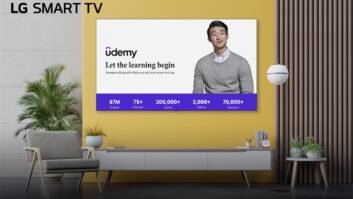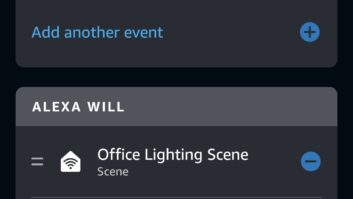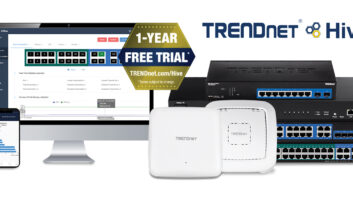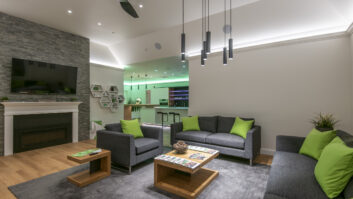Integrators Sound Off on the Impact of Mobile Applications

Crestron’s Mobile Pro G software uses mobile broadband or Wi-Fi communication to enable homeowners to view room and device status; select movies and music; adjust volume, climate, lighting and security. Mobile apps are a big deal. By virtue of their sheer number–there are purportedly a million currently available for download to various phones and tablets–apps have become a cultural phenomenon spurred on by consumer fondness for their convenience, looks, capabilities, and relative easy of use. Their impact on the custom integration market has been seismic, notable for the fact that many of the control and automation manufacturers that cater to the channel have not hesitated to join the fray with apps of their own.
This new development has been a welcomed one, for the most part; integrators that specialize in control and automation have embraced the integration of apps into their system designs with little complaint. While this might be true, it bares asking if control and automation apps, with all of their elegance and low-cost attainability, are poised to dramatically change the face and role of dedicated, custom-built control systems. For integrators, the answer is nuanced and influenced by their willingness to incorporate and adjust to the role of apps in their business models, while acknowledging that their businesses will also have to undergo changes to accommodate and inform eager customers that might not understand the limits of mobile applications.
“I often come across people in the industry who believe that the tablet/app revolution marginalizes our programming services while posing a significant threat to our overall business model,” said David Donofrio, president of The Audiocom Group. “I couldn’t disagree more. We view the proliferation of apps as a catalyst for growth. If we can provide beautiful, cost-effective control interfaces across devices people are looking to put to use, [then] the result should be faster system deployment, less costly back-end support, better control, and, most importantly, happier clients.”
Measuring Impact
On the face of it, mobile apps, whether living on the two most common portable operating systems–iOS and Android–are revolutionary. Moving beyond the gaming market, app developers harness the power of wireless connections to link mobile devices to other electronic sources to widen the usefulness of mobile phones and tablets. Indeed, the seeming simplicity of these connections has captured the imagination of consumers and has pushed developers, including those in the custom integration channel, to broaden the scope and capabilities of any given app. Witnessing such convenience, it is easy to see demand for greater control over everything from the television to home lighting growing. Could these possibilities– some already realized, others on the horizon– negatively impact the custom control market, which has traditionally offered robust and at times complex automation features?

Gregory L. Beese, whose fondness for “wellwritten” apps comes with an emphasis on network infrastructure, has already noticed a decrease in the amount of in-wall touchpanel devices being sold in lieu of tablets and phones being utilized to control various aspects of the home. “Yes and no,” said David Raines, president of Osbee Industries, which is based in Harrison, NY. “There are really two markets. The first is the walkin customer looking for an out-of-the box solution at low cost, using control devices they already own and are familiar with–like a smartphone or tablet. Apps have been game changers for this market, introducing them to control and automation that has been out of reach until now… The tech geek in me is really excited by all the possibilities.”
The second market, as explained by Raines, are affluent clients looking for whole-home integration solutions, especially for complex security and surveillance requirements. It is this latter group that he said presents the challenge.
“The hardest thing is to have a customer walk through the door armed with pages of internet research about this or that system and all these cool apps,” Raines explained. “Sure, it’s sexy to watch someone controlling their entire house from their cellphone. But in practice, we’ve found that more traditional devices like hard-wired touchscreens work best for complex home theaters and wholehouse automation and control. And I can tell you, of all our customers, the ones that were most insistent on using apps have been the first ones to ditch their cellphones and tablets in favor of their touchscreens. Everything we do is based on what our clients teach us. Complex, fully integrated homes still require custom engineering, design, programming, and installation.”
Raines’ observation has found consensus among his industry peers, including Panos Anassis, president of Audio Video Invasion in Plainview, NY, who sees apps as an integral part of introducing and educating the masses about the affordability, simplicity, and accessibility of automation.
“Apps raise consumer awareness to technology in general, and our industry is at the center of technology,” Anassis said. “Where there was once fear at the words ‘home automation,’ a more comfortable feeling is growing among consumers partly because apps have made certain complicated tasks easy. This feeds more interest, as well as exposure, between the consumer and the manufacturers in our industry, which in turn trickles down to the integrators.”
Mike Brummer of Mount Lookout TV in Cincinnati, OH, sees another benefit of apps: freeing integrators of hardware responsibilities.
“Hardware breaks, gets updated, and has to go in for service,” Brummer said. “We all know how much of a time vampire it is when a customer drops their remote, and it breaks. Then you have to program something you have in stock and let them borrow it, all the while not charging the customer if it is under warranty. When we do not supply the controller (phone or tablet), we don’t have to worry about servicing the controller hardware. If the phone or tablet breaks, the clients get a new one from [the manufacturer.] We don’t lose money on faulty controllers or warranty repairs.”

John Nagy, director of product management for CineTouch (makers of AMX programming software) said that like a typewriter with way too many keys, the proliferation of apps will approach the point at which so much is possible that nothing can be done. Brummer’s practical hardware point is given a boost by the president of Pennsylvania-based Creative Systems, Gregory L. Beese, whose fondness for “well-written” apps comes with an emphasis on network infrastructure.
“We have already seen a decrease in the amount of in-wall touchpanel devices being sold in lieu of tablets and phones being utilized to control various aspects of the home,” Beese said. “While this may decrease the overall probability on the hardware side of the project, there is an increased amount of labor and related profit with both programming the functions within the mobile app, as well as the [need] to install a more robust wireless network throughout the home.”
Citing today’s higher unified wireless networks standard, Beese added that the availability of access points to talk to the home’s central wireless controller allows for easier use of mobile devices ensuring “100-percent blanket coverage throughout the home so that all wireless devices can control the automation system or distributed audio/ video system without ever losing connectivity to the centralized core hardware components.”
Be warned, however, that these new high-end networks require network engineers to properly design and implement the sophisticated systems, Breese pointed out.
The magnanimity that some integrators feel toward apps, however, isn’t absent of worries. John Nagy, director of product management for CineTouch (makers of AMX programming software) sees one glaring problem of app proliferation. Comparing the rise of apps to that of the remote control where a godsend soon became a curse of too much, Nagy noted that “apps are going the route of remotes, but with an important new wrinkle; you can’t take part of an app and leave the rest. Their value is in their depth, and so is their curse.” You “need” all of each of them, not a cross section, and what’s more, a cross section won’t even work anymore. Indeed, preventing cooperation is a goal, as each vendor seeks to force more eye time on their own app in competition with the rest of the world.

Fully customizable using RTI’s Integration Designer programming software, the RTiPanel offers the same control experience RTI remote controls offer, running on the Apple iPad, iPod touch, iPhone, and Android devices. “Like a typewriter with way too many keys, the proliferation of apps will approach the point at which so much is possible that nothing can be done,” Nagy explained.
This wrinkle might have a positive in its crease, though. Echoing both Raines and Nagy in his examination of the relationship of apps to custom integration, Design Entertainment’s Tyler Schifferly said that too many apps might actually help integrators better sell custom control and automation.
“On the positive side, and one that is helping us sell more products like OnControls and Control4, is that everyone hates changing from app to app to control things,” Schifferly noted. “It may seem easy, but it is a huge pain to switch to your thermostat app, then your Blu-ray app, then your receiver app, then your TV app, then your lighting app, and so on, just to watch a movie. Somehow, we have gone back in time to having 10 different remotes again, and automation systems are the new ‘all-in-one remotes.’ In this case, they’re the all-in-one app.”
Harmonious Co-Existence
So perhaps the gnashing of teeth about a possible app takeover of the systems that have defined custom integration is a bit overwrought at this point in time. That’s the feeling of James Noble from Technology Proz, in Riverside, CT.
“Apps will never completely replace the need for all in-wall and or handheld remotes,” Noble said. “They do offer a great supplemental ability where appropriate. For example, intercom capabilities of an in-wall controller are not easily replaced with an app. For AV controls, a handheld remote will be able to offer a faster solution to muting the volume in the room if you needed to grab a phone call.”
An app could do that, Noble acknowledged, but you would need to load it, navigate to the appropriate page, and then tap “mute.” This process could take up to 20 seconds, whereas a handheld remote or touchpanel is only one button away from accomplishing the task.

The latest iteration of Savant’s iPad app caters to Apple’s Retina Display. “The ability of these two different ways to control things can complement each other in today’s client technology savvy world,” Noble said.
Simply stated, apps genuinely lack the robustness and responsiveness of dedicated control systems, therefore, hampering any Napoleonic aspirations consumers and worried CIs might envision. Custom integration’s not so secret weapon is, well, customization.
“Apps are doing things that no one could have envisioned even a few years ago. But apps can only go so far,” Raines said. “Many are difficult-to-impossible to customize. For large complicated systems, it’s still better to engineer and program on our own. It all gets back to a separation in the market–between the high-end client who has very specific and unique needs and the average Joe that can accomplish what he wants by going into a big-box store.”
From a business perspective, Anassis makes a great point about the mindset shift integrators will have to undergo with the many technology changes that are flooding in, moving from what he calls “lower project volume and higher per system revenues” to a proper embracing of “the lower per-system revenue, higher volume mindset,” which he believes will make or break integrators in the channel.

URC’s Total Control Mobile iOS app enables end users of URC Total Control systems to access all the benefits of Total Control through three additional devices–the iPad, iPhone, and iPod touch.
“With a larger DIY client base developing, yes, a certain market share will definitely dry up and affect both integrators and manufacturers,” Anassis explained. “The last decade has shown that control system installation complexity and price has decreased while at the same time, system functionality and ease of use has increased. What we need to accept is that while there will be more DIY products out there, at the same time, the consumer awareness will bring in new layers of consumers who will still want to ‘take control’ of their environments, but will not be comfortable in doing it themselves. They will reach out to local professionals. At the end, in my point of view, the trade-off will be more substantial, even though integrators will need to adjust to the different dynamics that will develop as the market shifts take place.”
Moving Forward with Confidence
Like other segments of custom integration, adjusting to technologies that did not originate in our business has been key to keeping the custom installation niche not only relevant, but also thriving. Apps are augmenting integrators’ approaches to their projects, and in the process, new business models are emerging. At the same time, integrators are better able to identify the strengths and weaknesses that a marriage of apps and custom systems produce.
Integrators have already begun to identify where the influence of apps can help custom control and automation manufacturers raise the product bar. Of special note is the call for voice activation in custom control systems, inspired by Apple’s Siri.
“If you have ever tried any of the automation/ control voice software apps out there, you know that you would have been better off spending that $100 on Rogaine, as many people have pulled their hair out trying to get these systems to perform basic voice recognition functions,” Beese said. “I long for the day when I can have a ‘normal’ conversation with a computer. I can tell her to ‘wake me up’ at a certain time, remind me to ‘take out the trash,’ ‘dim the lights,’ ‘play my favorite music,’ and so on. Whoever can take the concept depicted from within the LA home of the Iron Man film will be positioning themselves for market domination in this industry.”
Overall, though, tighter integration between apps and controls systems is something that most integrators will stand up and cheer for, especially if a unified app infrastructure can be established to streamline control and establish a better handshake between diverse electronic products and components.
“Tomorrow’s appliances, and the apps they come with, will need to come to grips with the deeper meaning of being ‘connected,’” Nagy said. “It’s not just to be reachable on a network. To be ���connected’ in the next decade should–inevitably must–mature into a sacrifice of individuality in favor of some standards of shared protocols, of common APIs.”
Nagy said that an ideal app would introduce itself to the home and publish its capabilities, much like printers and displays do now on our computers. Then “integrated” controls could avail themselves of high-level functions, like we do now for a DVD player. But then the high-level integration would offer a seamless gate into the specialized app when the user wanted that depth… then back to the simple interface that offers breadth of control across many devices with one familiar UI.”
Based in Brooklyn, NY, Llanor Alleyne is a contributing editor to Residential Systems.





